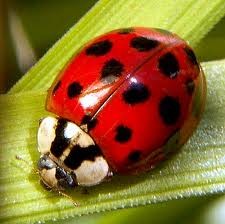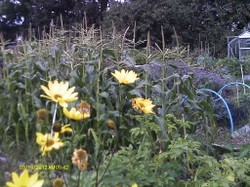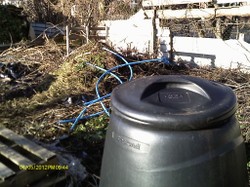For many vegetable gardeners like you and me, especially for the newbie gardener, the mere sighting of a strange looking bug in our prized vegetable plants is a bit unsettling. For the most part, I believe we will agree the first thing that crosses our mind is to either swat at or kill the invading insect.
After all, beneficial insects such as the praying mantis are downright scary looking. All though good bugs to have in our gardens, not only do they hunt, kill, and eat, the bad bugs that live to devastate all our fruit and veggie plants in our container gardens, raised beds or hanging baskets. The alien looking beneficial bug gives us a good scare, but that is due to in large part because we have not learned to appreciate our little organic gardening, insect pest controlling beneficial insects.
What do you say, let us take a good look at all the good the wingless praying mantis, ladybug, and green lacewing and let us not forget the unappreciated beneficial nematodes that work to keep our gardens soil and plants healthy, and productive.

What are Beneficial Insects and Why are they a Gardeners Best Friend
by teddletonmr
Good bugs control aphids, thrips, mealy bugs, scale insects, mites, and whiteflies in our flower and vegetable gardens organically…
Praying Mantis is a good bug
Using Praying Mantids and Ladybugs in the garden as organic pest control
The cannibalistic praying mantis would just as soon devour a young wingless praying mantis, aphid-eating ladybug or green lacewings as well as all the bad bugs.
Praying Mantids or Praying Mantis if you prefer, is a large stick like beneficial insect that measures from two and one half inch to four inches long. Green or brown in color to match its surroundings, praying mantis have a set of large eyes located on both sides of its triangular shaped head. Adults have papery wings, where the immature insects resemble adults but are smaller and wingless.
Well-camouflaged predatory slow moving insects, the pray mantis have long front legs adapted for grabbing, and holding their prey. They are quite honestly, cannibalistic feeders, other praying mantis and other good bugs are welcome meals to this veracious feeder, it is that whole survival of the fittest thing.
Praying mantis survives cold winters as eggs deposited in a paper like egg case. This makes it easy for organic vegetable gardeners to purchase the egg sacks that contain hundreds of eggs, from an online store such as amazon.com, or local garden center. Then put the praying mantis egg case in the garden, and let nature take its course.
Buy your Praying Mantis, Ladybugs and Beneficial Nematodes here
 |  |  |
| 2 Egg Cases Chinese Praying Mantis 10... Only $14.99 | Orcon LB-C1500 Live Ladybugs, Approxi... Only $19.99 | Dr. Pye's Scanmask 7 Million Live Ben... |
Ladybugs AKA Ladybeetles & Ladybird beetles
Ladybugs are cute beneficial insects that help to control Aphids
Ladybugs, Lady beetles, or Ladybird beetles whatever you choose to call them. These well-known beneficial insects are not scary looking like the praying mantis and other predatory insects. Actually, ladybugs are somewhat cute. They come in a varitity of colors, reddish, orange, or black with spots, depending on species.
The Ladybugs larvae is elongated, one quarter of an inch to one half inch in length, covered with tiny spines, and are grey or black with blue and orange markings. Adult ladybugs are attracted to plant blossoms and blooms full of pollen and nectar. Both adults and larvae help to control aphids, thrips, mealy bugs, scale insects, mites, and whiteflies in our organic flower and vegetable gardens.
Green lacewings
Green lacewings are a great organic option for controlling insect pests in the garden
Adult green lacewings are also good bugs as an organic method of pest control in the vegetable garden, pale green or brown in color, measuring from one half inch to three quarters of an inch in length. Lacewings have slender bodies with, large transparent highly veined wings they hold over their body when they are resting. Green Lacewings lay eggs with stalks. Their Larvae is yellowish-grey, mottled, spiny, and have long curved thin pincher like jaws. In the Larvae stage, Green Lacewings also called, antlions, or aphid lions, hunt and eat aphids, mealy bugs, mites, scale insects, whiteflies, thrips, and insect eggs.
Benefits of Companion Planting
Companion planting is a great way to keep and attract beneficial insects to our garden
While we are talking about using good insects to control the bad bugs organically, many vegetable gardeners have great success using companion planting. This provides the beneficial insects with all the incentive to stay around our garden, thereby keeping the annoying insect pests under control.
Gardeners Benefit from Succession Planting
Organic gardeners should consider Succession planting of annual flowers that support beneficial insects
Beneficial insects are constantly on the prowl hunting for prey. Flowers attract these beneficial insects to your garden, give them welcomed nourishment, and entice them to stay around searching your organic garden for plant eating insects. Planting the right kind of flowers, at the best possible times, of the growing season will increase the likelihood that beneficial insects will call your vegetable garden home and lay eggs on your vegetable plants. There by their eggs will hatch, and their young will most likely call your garden plants home, feed on all the harmful pest insects such as aphids, caterpillars, leaf beetle larva, trips, spider mites and whiteflies which I believe you agree, is a very good thing indeed.
Useful plants for supporting good vegetable garden insects generally have small blooms and flowers with easily accessed nectar and pollen. Umbels, such as or cilantro when young and tender, Bouquet variety of dill, fennel and caraway are very attractive plants to many good garden insects. Alyssum, flowering buckwheat, black-eyed Susan, dwarf sunflowers and yarrow look great in our vegetable gardens, and are extremely attractive to many of the helpful garden bugs.
Organic gardeners should only need to plant five, to ten percent, of their vegetable garden in these types of annual flowers in order to attract the beneficial insects. The annual flowering plants do not necessarily need planting all in one space to attract good garden bugs. Rather consider planting some annuals in odd corners and out of the way spaces in the garden that separate, let us say, pepper, tomato, eggplant, zucchini and cucumber plants.
Plant annual flower seeds three to four weeks apart, this will attract and support beneficial insects through the entire growing season, this trick will keep some plants flowering all the time, and ensure the beneficial insect colonization process continues in our garden. You see most annuals flower every six to eight weeks, this makes it a good idea to plant a few seeds every three or four weeks to ensure flowers are always in bloom.
When and what is the best companion plants for planting around the garden
Annual flowering plants attract and keep beneficial insects to our vegetable gardens
● Spring, alyssum, buckwheat
● Early summer, coriander, dill, yarrow, buckwheat
● Mid-summer, coriander, fennel, dill, caraway, black-eyed Susan, yarrow, dwarf sunflowers
● Late summer, coriander, dill, black-eyed Susan, dwarf sunflowers
● Fall, alyssum, buckwheat, dwarf sunflowers
Beneficial Nematodes
Beneficial Nematodes control insect pest in our garden soil
Beneficial Nematodes are microscopic insects, that seek out and destroy several hundred kinds of soil dwelling, wood boring, undesirable insects in our organic vegetable gardens, such as flea larvae, white grubs, cutworms, corn rootworms, strawberry weevils, gypsy moth larvae, cabbage root maggots, fungus gnat larvae, armyworms, weevils, grubs. Just to name a few we organic gardeners find bothersome.
These beneficial bugs are safe for us humans, our pets, and the environment. Beneficial Nematodes are compatible with other beneficial garden insects such as ladybugs, lacewings, and praying Mantids, and do not harm earthworms. Shipped live in a box, available for purchase on line from your favorite online store like amazon.com, or purchased locally from your favorite garden supply store.
Simply mix them directly into your organic vegetable garden soil, by simply applying them mixed in a water solution in your clean insecticide free garden sprayer, mixed directly into the soil, planting mix or organic mulch, and feel good about this organic garden insect pest control method.
Professional quality lawn and garden sprayer
Solo sprayer, mists, sprays a wide fan or narrow stream making control easy
 |  |  |
| Solo 430-2G 2-Gallon Farm and Garden ... | Solo 425 4-Gallon Professional Piston... Only $89.95 | New - Piston Sprayer 1 Gal Spritzer b... |
Bees and butterflies
Bees and butterflies pollinate our favorite flower and vegetable plants
The most important thing we gardeners should remember, regardless the pest control method we prefer to use, the organic approach, or harsh chemical insecticides. Not all beneficial insects are predators specializing in insect pest control for our vegetable gardens. Many help with cross-pollination of our flowering fruit and vegetable plants. Take honey Bees and butterflies for instance, these little beauties land on one blossom, collect the pollen, when they are finished feeding and collecting pollen they move to the next flowering plant. Where in turn depositing some of the pollen from the first plant, pollinates the second plant so it will produce higher quality fruits, veggies, and beautiful sweet smelling flowers in our gardens.
Keep in mind, before we rely on beneficial insects such as, bees and butterflies to pollinate our garden vegetables, we first must attract them. There are specific plants best used to attract these beneficial pollinators.
Master and newbie gardener’s favorite plants for attracting pollinating insects
Attracting Butterflys and Honeybees to our gardens help to control plant distroying insects
Queen Anne’s lace,
Butterfly weeds,
Flowering herbs,
Marigolds,
Dandelions,
As well as many other flowering plants with sweet smelling blossoms are great choices. When we use these varieties of flowering plants in our gardens, we increase the likelihood of not only beneficial pollinating insects but ladybugs as well will be calling our organic garden home, and help us with controlling the destructive insects wanting to make a meal of our delicious fresh fruits and veggies.
Butterfly and Honeybees favorite Flowering plants
Keep Butterflys and Honeybees coming back to your gardens
 |  |  |
| 1 Oz Queen Anne's Lace (Ammi majus) B... Only $6.48 | Black-Eyed Susan - 100 Seeds, 250 mg ... Only $2.99 | Crackerjack Marigold 500 Seeds - PLUS... Only $3.75 |
Benefits and rewards of organic gardening
Organic gardening should include using beneficial insects to control the bad bugs in our gardens
When it comes to our organic vegetable gardens, after fertilizers, and watering, our biggest concern I believe you will agree is, insect pest control. After all, as organic gardeners we need to be mindful of controlling all the bad bugs in our gardens that left unchecked will devastate our fruits and veggies. However, we certainly do not want to harm the beneficial insects that help pollinate all our vegetable plants in the process.
Using companion planting that will both attract and keep all the good bugs happy in our gardens. Makes controlling the destructive bugs organicallyly that are hell bent on eating our vegetable and flower garden plantseasier, and let us not forget, better for the environment.
Happy gardening, Mike
Organic Gardening Tips
Garden tiller review
Organic Insect Pest Control
Bugs in the garden freak you out here is an easy to use solution for controlling the bad bugs in your gardens
Have a grup problem?
Naturally occuring microscopic bacteria that kills japanese beetle grubs before they become adults
 |
| Milky Spore Powder (10 oz. Shaker) |
You might also like
Revamping the AllotmentNo garden design is for ever, and this year I am having to make some changes ...
Dark Gold: Garden CompostCompost is a wonderful addition to a garden, but there is a variety of types ...

















 Apple Watch the Best Talking Watch Bargainon 01/16/2023
Apple Watch the Best Talking Watch Bargainon 01/16/2023
 In-depth review of a Bushcraft Backpacking Survival hatcheton 12/05/2014
In-depth review of a Bushcraft Backpacking Survival hatcheton 12/05/2014
 Winterizing windows – Easy and inexpensive DIY projecton 11/17/2014
Winterizing windows – Easy and inexpensive DIY projecton 11/17/2014
 Growing cucumbers on a trellis is fun and easyon 08/05/2014
Growing cucumbers on a trellis is fun and easyon 08/05/2014


Post your Gardening Questions and Comments Here
MikeRobbers happy to introduce you to a few good bugs.
happy travels, and success in the garden. Mike
Informative article and tips about gardening and the beneficial role of certain bugs. Wasn't aware of all of these bugs so your information is quite helpful.
frankbeswick good to meet you, thanks for reminding to always be mindful of the importance of the proper temperature range required to activate nematodes in the garden soil.
Welcome to the Wizzley community, happy gardening. Mike
sheilamarie you are welcome, happy gardening. Mike
When applying nematodels, ensure that you do so when the temperature conditions are right for them. They need a certain temperature level to be activated.
I was familiar with many of your suggestions, but didn't know about the lacewings, though I've seen them around. Thanks for that tidbit!
Ah yes here's the page with the beneficial insects. I've planted my &*#&%$ off over the past week and need to take every precaution to protect my plants.
:) Yea I still love teddy bears. There was an adjoining site all about them that I wrote too but I decided not to put it in there (as it's not my site anymore)...
I spent last night making a video tutorial about all the marvels of the Wizzley site, trust me I know how great the site is, it's like Squidoo and Hubpages had a baby and it was born a genius :) (but had all the best traits of the other two).
I'm working on building a Wizzley U sort of wizzle full of videos on everything- my motivation was to use this to help anyone I bring here (affiliate joins) and if WZ wants them they can have them too... I love going through articles here as the capability for creativity is amazing and a lot of sites are truly unique in the way people format them :)
ok I'm a bit off topic for this wizzle so I'll stop :) Again, great article I'm on my way to check out a few more of your masterpieces...
Hey Jerrico, good to hear from you. Your wizz on the Teddy Bear tuggs at the ole heart strings.
As for the close tie with @katiem2, thanks for the complement, let us not forget the Wizzley team and the platform that makes it all possible.
Happy gardening, Mike
That is one of the best wizzles I've seen so far (Katie's bring an extremely close tie) (as far as cool factor, formatting, content brilliantly written, usefulness (concept), monetization (amazing balance and enticement of topic for kids and families), creativity factor (love the image lines you put between sections with the grey back ground!), and the incredible social response (likes, tweets, G+, Wz likes, comments etc...).
Kudos! Just giving some Wizzley love, my brain almost exploded just looking at this :) I'm a fan!
Jerrico